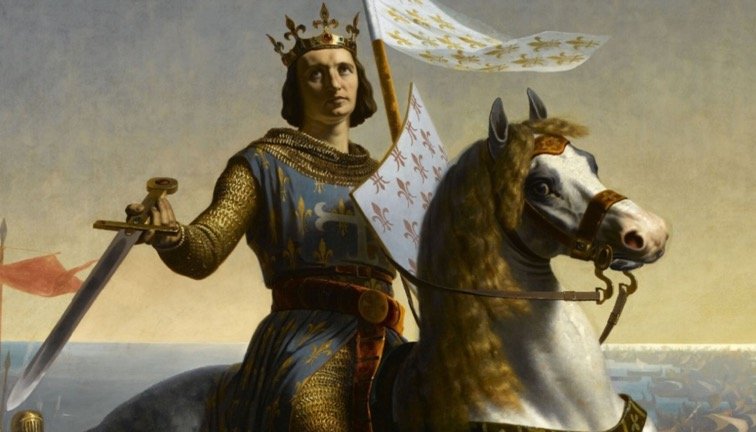Louis IX of France (r. 1226–1270) was crowned at age twelve, governed first under his mother Blanche of Castile, led the Seventh Crusade to Egypt where he was defeated and captured at Fariskur (1250), paid a massive ransom and remained in the Holy Land to fortify Christian strongholds, then later launched the Eighth Crusade to Tunis, where dysentery killed him in 1270. Despite military failure, his personal piety, justice reforms, and diplomacy earned him canonization (1297) and a lasting global legacy.
Early Life & Bloodlines
Born April 25, 1214, Louis was the fourth son of King Louis VIII and Blanche of Castile. With his elder brothers dead, he became heir. Through Blanche, he descended from Henry II of England and Eleanor of Aquitaine; through his father, from Philip Augustus—giving him impeccable Capetian and Plantagenet credentials.
He was educated in Latin, governance, and the military arts. At age twelve, after his father’s death, Louis was crowned at Reims (November 29, 1226).
Minority Rule: Blanche of Castile’s Steady Hand
As queen regent, Blanche stabilized the realm, guided her son’s intense piety, and concluded the Albigensian conflict with Raymond VII of Toulouse. Louis began personal rule around 1234, marrying Margaret of Provence, whose own devoutness matched his—though tensions with Blanche occasionally strained the royal household.
Louis’s reputation for holiness never eclipsed his political instincts: he arbitrated disputes among European rulers and built a profile as the ideal Christian monarch.
Why the Seventh Crusade Happened
After Jerusalem fell in 1244, crusader prospects dimmed and the Mamluks rose to power. In that atmosphere, the “model” Christian king felt bound to act. Louis took the cross to restore Christian control of the Holy Land and reassert crusader strength.
The Seventh Crusade (1248–1254): Triumph, Disaster, Captivity
- Landing and Early Success (1249): Louis’s army captured Damietta in Egypt—an impressive opening move while Sultan al-Malik as-Ṣāliḥ lay dying.
- March on Cairo: The success unraveled as the army slogged through the Nile Delta during flood season and searing heat, suffering disease, dehydration, and attrition.
- Battle of Fariskur (February 8, 1250): The turning point. Turanshah’s forces decisively defeated the crusaders; Louis was captured.
- Ransom & Release: Louis’s freedom cost 400,000 livres tournois and the surrender of Damietta—a staggering sum that required Templar loans.
What Louis Did Next (and why it matters)
Instead of sailing straight home, Louis stayed in the East until 1254, shoring up defenses at Acre, Jaffa, and Caesarea, and negotiating with Muslim powers. This phase shows him as a builder and diplomat—more effective with walls and treaties than with battlefield gambits.
Between Crusades: A Devout King at Home
Back in France, Louis resumed reforms and peacemaking while maintaining correspondence with Mongol leaders, reflecting the era’s widening diplomatic horizons. His courts cultivated justice, charity, and administrative order, reinforcing his image as a “monk-king” who still understood statecraft.
The Eighth Crusade (1270): Final March and Death at Tunis
In 1267 Louis vowed another expedition, this time to Tunis, to support missionary activity and pressure North African routes. The army landed at Carthage (July 17, 1270). Then disaster struck: disease swept the camp. Louis died of dysentery on August 25, 1270, age 56. His son succeeded him as Philip III.
Canonization and Global Legacy
Recognized as the exemplar of Christian kingship, Pope Boniface VIII canonized Louis in 1297. His feast day remains August 25. Cities and institutions worldwide bear his name—St. Louis (USA), Saint-Louis (Senegal), San Luis (Argentina, Philippines), and countless churches, hospitals, and schools—testimony to a reputation that outlived his campaigns.
Was Louis IX a “Great” King?
Measured purely by battlefield outcomes, no: both crusades failed strategically. But measured by piety, justice, diplomacy, and statecraft, he stands out. Medieval ideals prized the warrior-king; Louis blended that model with conspicuous personal holiness and administrative competence. In the high age of crusading, that combination made him an icon—strong enough to be a saint.
Key Dates at a Glance
- 1214: Birth of Louis IX (April 25)
- 1226: Crowned King at Reims (age 12)
- 1234: Begins personal rule; marries Margaret of Provence
- 1249–1250: Seventh Crusade in Egypt; captures Damietta; defeat and capture at Fariskur
- 1250–1254: Remains in the Levant fortifying crusader ports
- 1270: Eighth Crusade to Tunis; dies of dysentery (Aug 25)
- 1297: Canonized by Pope Boniface VIII











































